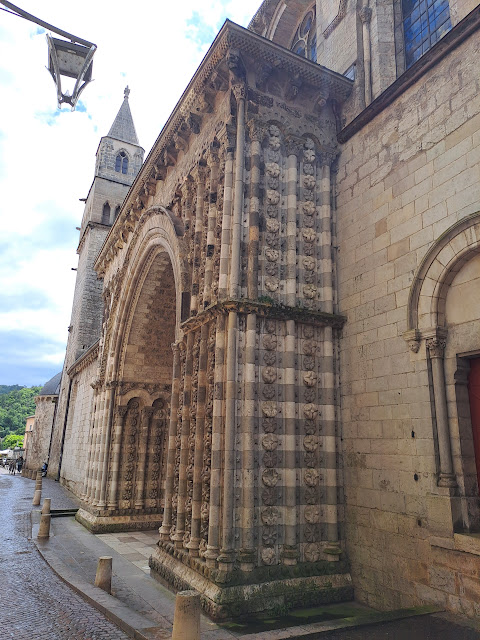Our second stop over during our Month in France in June was Cahors, a town known for its red wine.
Cahors sits on a loop in the River Lot and is surrounded by limestone hills. One of the 13 departments of the Occitanie region its history dates back to Roman times.
Our first evening we strolled along the Lot, caught a glimpse of the Pont Valentré and the Roman town walls.
The next morning on our walk into Cahors we passed the Barbican which protected the Barre Gate into the town. An impressive structure not least because of the staircase hidden in the open sided tower.
The portal entrance is a beautiful set of arches with rose designs. It is almost hidden in a small side street as is the entrance now used for visitors on the opposite side. The main doors below a stunning rose window face onto the open square but once inside these door are above the Cathedral floor and are reached by a wide staircase.
Inside was beautiful, not overwhelmingly decorated as some Roman Catholic churches are but in a dedicated artistic way. The wall panels were so intricately painted with the arched roof design leading to a stunning circular design.
It was quite bright inside but I managed to darken my camera to capture the beautiful windows.
We ventured through a small doorway and to our amazement discovered cloister. It was such a surprise as in the city there didn't seem any room for an outer courtyard. The Gothic style cloister was built in 1504, it was so peaceful.
As we wandered round this beautiful building it was interesting to see the difference architectural influences, especially the Roman styles.
After visiting the Cathedral we wandered to the edge of the city to look over the east loop of the Lot, back through Cahors streets and visited the indoor market with many food and wine sellers.
After lunch in one of the many bars and restaurants we walked to the west side of Cahors to the Pont Valentré, an important river crossing used by pilgrims on the way to Santiago de Compostela.
The bridge with its six spans was built in the 14th Century. It took 70 years to build the bridge and to hurry the work along it is said that the foreman made a pact with the Devil who agreed to use his skills to speed up the work in return for the foreman's soul.
As the bridge was built on time to save his soul the foreman sent the Devil to collect water using a sieve. The Devil, realising he had been tricked, sent a demon each night to loosen the final stone in the central tower, thus ensuring the bridge was never finished and needed daily repairs.
However when the bridge was restored in 1878 a sculpture of an imp was put on the central tower, thus confusing the Devil who thinks the imp is doing his work.
Cahors is an interesting city with a variety of historic buildings. Being a wine appellation there are quite a few Cahors wine bars and shops but to learn more it's probably better to visit one of the vineyards.
It's a super stopover location, one we would use again if travelling south.


















No comments:
Post a Comment